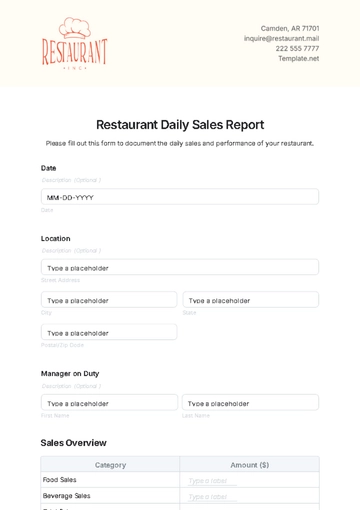Free Furniture Store Report

I. Executive Summary
[Your Company Name] demonstrated strong growth and resilience in the furniture retail industry for the year [2055]. The store's commitment to customer satisfaction, sustainable product lines, and innovative design drove significant increases in both sales and customer retention. Overall revenue for the year reached [$4,200,000], marking a [15%] increase from the previous year.
II. Market Trends and Analysis
Understanding the current market trends is critical for long-term business success. This section explores the prevailing trends in the furniture industry that influenced [Your Company Name]’s operations, including consumer preferences for sustainable materials, innovative design, and digital shopping experiences.
Sustainability Focus: Eco-conscious consumers drove demand for products made from recycled or sustainably sourced materials, accounting for [35%] of total product sales. Custom furniture lines featuring sustainable wood and fabric saw a [25%] increase in demand.
Smart Furniture Integration: The trend towards smart furniture with integrated technology saw higher-than-expected growth, particularly in office furniture, where demand for ergonomic and tech-enabled solutions increased by [30%].
Digital Shopping Experience: Shoppers increasingly opted for online purchases, utilizing the website’s virtual showroom. Furniture customization options online were a significant factor in customer satisfaction, contributing to the strong performance of the e-commerce platform.
III. Operational Efficiency
The efficiency of operations directly impacts a company’s ability to serve its customers, manage inventory, and maintain profitability. This section details the operational strategies and efficiencies adopted by [Your Company Name], focusing on store management, supply chain improvements, and employee productivity.
Inventory Management: Real-time inventory tracking was implemented, reducing stock-outs by [12%]. This system enabled better forecasting of product demand and more efficient reordering processes.
Supply Chain Optimization: Partnerships with local suppliers for sustainable materials streamlined delivery timelines, reducing delays and improving product availability by [8%].
Employee Productivity: In-store staff training programs focusing on customer service and product knowledge were conducted quarterly. This improved employee efficiency and contributed to higher customer satisfaction scores.
IV. Marketing and Customer Engagement
Marketing plays a critical role in attracting and retaining customers. This section discusses the various marketing strategies employed by [Your Company Name], which contributed to higher sales and brand recognition.
Digital Marketing Campaigns: Targeted social media ads, email marketing, and influencer partnerships helped drive both online and in-store traffic. These campaigns yielded a [30%] increase in website visitors and a [15%] boost in conversion rates.
Customer Loyalty Programs: The loyalty program introduced mid-year saw over [5,000] customers enrolled, leading to a [10%] increase in repeat purchases.
Seasonal Promotions: Effective seasonal sales during peak times, particularly during Black Friday and mid-year clearance events, helped clear old inventory while maintaining strong sales figures.
V. Financial Overview
A comprehensive financial analysis provides insight into the profitability and long-term sustainability of the business. This covers the key financial metrics for [Your Company Name] in [2055], including revenues, expenses, and profitability.
A. Revenue Breakdown
Category | Revenue | Growth |
|---|---|---|
Living Room Furniture | $1,500,000 | 20% |
Bedroom Furniture | $1,200,000 | 10% |
Office Furniture | $700,000 | 5% |
Custom Furniture | $400,000 | 12% |
Online Sales | $1,800,000 | 18% |
Living room and bedroom furniture sales contributed significantly to overall revenue. Online sales accounted for a substantial portion of total revenue, indicating a strong digital presence. Custom furniture offerings also saw solid growth, reflecting consumer interest in personalized, high-quality pieces.
B. Profitability Metrics
Gross Margin: | 64% |
|---|---|
Net Profit Margin: | 33% |
Return on Investment (ROI): | 15% |
The high gross margin is due to effective cost control and strong pricing power in the market. Net profit margins were healthy, despite increased operational investments in inventory management and digital marketing.
VI. Next Steps and Recommendations
[Your Company Name] must continue to build on its successes while addressing areas of potential improvement. This section outlines strategic recommendations for the upcoming year to ensure continued growth and customer satisfaction.
Expand Custom Furniture Offerings: Given the rising demand for personalized items, [Your Company Name] should increase its range of custom furniture, focusing on eco-friendly and tech-enabled products.
Enhance Digital Marketing and E-commerce: Continue to invest in digital marketing strategies and improve the website’s user experience to further grow online sales.
Sustainability Initiatives: Expand the use of sustainable materials and promote the eco-friendly aspects of the business to attract more environmentally conscious consumers.
Increased Supply Chain Efficiency: Strengthen relationships with suppliers to further reduce lead times and maintain inventory levels, ensuring product availability meets demand.
VII. Conclusion
The year [2055] was highly successful for [Your Company Name], marked by increased sales, improved customer satisfaction, and operational efficiencies. By focusing on expanding product offerings, enhancing its digital presence, and maintaining a commitment to sustainability, the company is well-positioned for continued growth in the coming year.
- 100% Customizable, free editor
- Access 1 Million+ Templates, photo’s & graphics
- Download or share as a template
- Click and replace photos, graphics, text, backgrounds
- Resize, crop, AI write & more
- Access advanced editor
Track your store’s performance with the Furniture Store Report Template from Template.net. This editable and customizable template helps you create detailed reports on sales, inventory, or financials. Personalize the sections, charts, and data presentation using our Ai Editor Tool to ensure your reports are clear, professional, and useful for decision-making.
You may also like
- Sales Report
- Daily Report
- Project Report
- Business Report
- Weekly Report
- Incident Report
- Annual Report
- Report Layout
- Report Design
- Progress Report
- Marketing Report
- Company Report
- Monthly Report
- Audit Report
- Status Report
- School Report
- Reports Hr
- Management Report
- Project Status Report
- Handover Report
- Health And Safety Report
- Restaurant Report
- Construction Report
- Research Report
- Evaluation Report
- Investigation Report
- Employee Report
- Advertising Report
- Weekly Status Report
- Project Management Report
- Finance Report
- Service Report
- Technical Report
- Meeting Report
- Quarterly Report
- Inspection Report
- Medical Report
- Test Report
- Summary Report
- Inventory Report
- Valuation Report
- Operations Report
- Payroll Report
- Training Report
- Job Report
- Case Report
- Performance Report
- Board Report
- Internal Audit Report
- Student Report
- Monthly Management Report
- Small Business Report
- Accident Report
- Call Center Report
- Activity Report
- IT and Software Report
- Internship Report
- Visit Report
- Product Report
- Book Report
- Property Report
- Recruitment Report
- University Report
- Event Report
- SEO Report
- Conference Report
- Narrative Report
- Nursing Home Report
- Preschool Report
- Call Report
- Customer Report
- Employee Incident Report
- Accomplishment Report
- Social Media Report
- Work From Home Report
- Security Report
- Damage Report
- Quality Report
- Internal Report
- Nurse Report
- Real Estate Report
- Hotel Report
- Equipment Report
- Credit Report
- Field Report
- Non Profit Report
- Maintenance Report
- News Report
- Survey Report
- Executive Report
- Law Firm Report
- Advertising Agency Report
- Interior Design Report
- Travel Agency Report
- Stock Report
- Salon Report
- Bug Report
- Workplace Report
- Action Report
- Investor Report
- Cleaning Services Report
- Consulting Report
- Freelancer Report
- Site Visit Report
- Trip Report
- Classroom Observation Report
- Vehicle Report
- Final Report
- Software Report





























